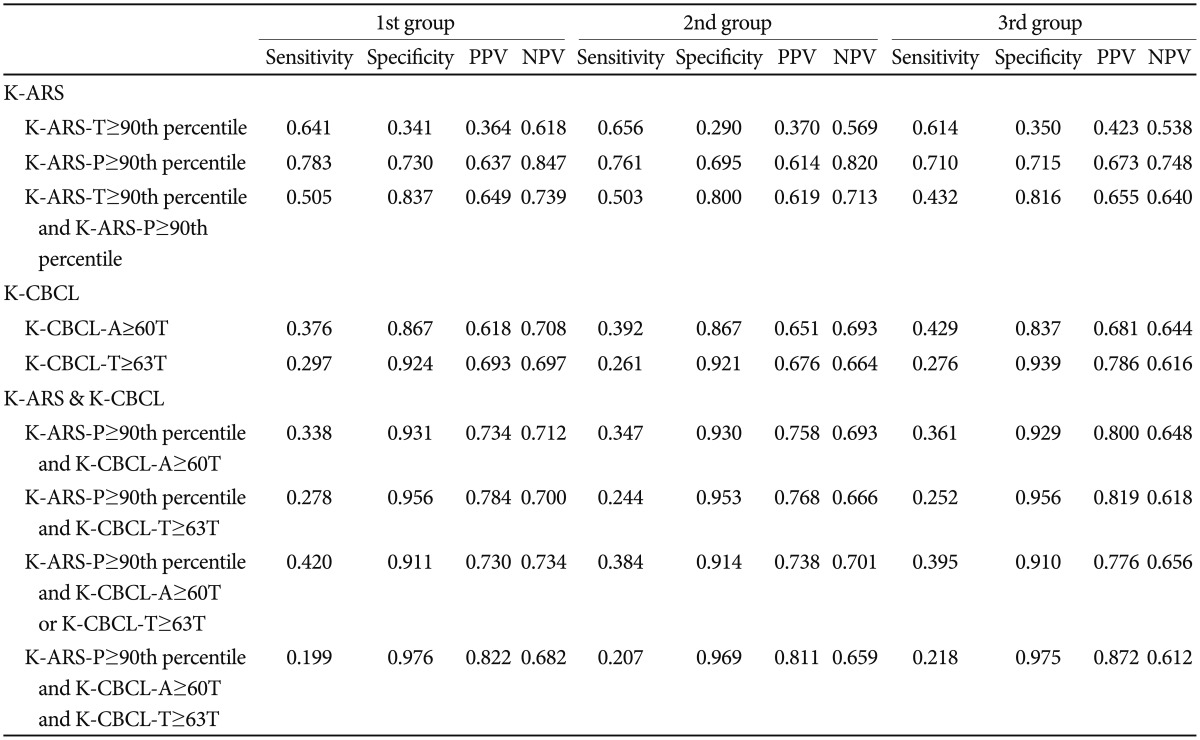1. American Psychiatric Association. Diagnostic and Statistical Manual of Mental Disorders, Fourth Edition. Washington DC: American Psychiatric Association; 1994.
2. Skounti M, Philalithis A, Galanakis E. Variations in prevalence of attention deficit hyperactivity disorder worldwide. Eur J Pediatr 2007;166:117-123. PMID:
17033803.


3. Yang SJ, Cheong S, Hong SD. Prevalence and correlates of attention deficit hyperactivity disorder: school-based mental health services in Seoul. J Korean Neuropsychiatr Assoc 2006;45:69-76.
4. Ghanizadeh A, Mohammadi MR, Moini R. Comorbidity of psychiatric disorders and parental psychiatric disorders in a sample of Iranian children with ADHD. J Atten Disord 2008;12:149-155. PMID:
18319376.


5. Kim JW, Park KH, Cheon KA, Kim BN, Cho SC, Hong KE. The child behavior checklist together with the ADHD rating scale can diagnose ADHD in Korean community-based samples. Can J Psychiatry 2005;50:802-805. PMID:
16408529.


6. Spencer TJ, Biederman J, Wilens TE. Attention-deficit/hyperactivity disorder and comorbidity. Pediatr Clin North Am 1999;46:915-927. PMID:
10570696.


7. Biederman J. Attention-deficit hyperactivity disorder: a selective overview. Biol Psychiatry 2005;57:1215-1220. PMID:
15949990.


8. Barkley RA. Comorbid Disorders, Social and Family Adjustment, and Subtyping. Attention-Deficit Hyperactivity Disorder: A Handbook for Diagnosis and Treatment. New York: The Guilford Press; 2006.
9. Bagwell CL, Molina BS, Pelham WE Jr, Hoza B. Attention-deficit hyperactivity disorder and problems in peer relations: Predictions from childhood to adolescence. J Am Acad Child Adolesc Psychiatry 2001;40:1285-1292. PMID:
11699802.


10. Hechtman L, Weiss G. Controlled prospective fifteen year follow-up of hyperactives as adults: non-medical drug and alcohol use and anti-social behaviour. Can J Psychiatry 1986;31:557-567. PMID:
3756759.


11. Loney J, Kramer J, Milich RS. The Hyperactive Child Grows Up: Predictors of Symptoms, Delinquency and Achievement at Follow-Up. In: Gadow KD, Loney J, editor. Psychosocial Aspects of Drug Treatment for Hyperactivity. Boulder, CO: Westview Press, 1981.
12. Spencer TJ, Biederman J, Mick E. Attention-deficit/hyperactivity disorder: diagnosis, lifespan, comorbidities, and neurobiology. Ambul Pediatr 2007;7(1 Suppl):73-81. PMID:
17261486.


13. Barkley RA, Fischer M, Smallish L, Fletcher K. The persistence of attention-deficit/hyperactivity disorder into young adulthood as a function of reporting source and definition of disorder. J Abnorm Psychol 2002;111:279-289. PMID:
12003449.


14. Barkley RA. Major life activity and health outcomes associated with attention-deficit/hyperactivity disorder. J Clin Psychiatry 2002;63(Suppl 12):10-15. PMID:
12562056.
15. Biederman J, Faraone S, Milberger S, Guite J, Mick E, Chen L, et al. A prospective 4-year follow-up study of attention-deficit hyperactivity and related disorders. Arch Gen Psychiatry 1996;53:437-446. PMID:
8624187.


16. Mannuzza S, Klein RG, Bessler A, Malloy P, LaPadula M. Adult outcome of hyperactive boys. Educational achievement, occupational rank, and psychiatric status. Arch Gen Psychiatry 1993;50:565-576. PMID:
8317950.


17. Spencer T, Biederman J, Wilens TE, Faraone SV. Adults with attentiondeficit/hyperactivity disorder: a controversial diagnosis. J Clin Psychiatry 1998;59(Suppl 7):59-68. PMID:
9680054.
18. Biederman J. Attention-deficit/hyperactivity disorder: a life-span perspectives. J Clin Psychiatry 1998;59(Suppl 7):4-16. PMID:
9680048.
19. Klassen AF, Miller A, Fine S. Health-related quality of life in children and adolescents who have a diagnosis of attention-deficit/hyperactivity disorder. Pediatrics 2004;114:e541-e547. PMID:
15520087.


20. Achenbach TM, Edelbrock C. Manual for the Child Behavior Checklist and Revised Child behavior Profiles. Burlington: University of Vermont; 1983.
21. Achenbach TM. Manual for the Child Behavior Checklist/4-18 and 1991 Profile. Burlington: University of Vermont; 1991.
22. DuPaul GJ, Stoner GD. ADHD in the Schools: Assessment and Intervention Strategies. New York: Guilford; 1994.
23. Biederman J, Monuteaux MC, Greene RW, Braaten E, Doyle AE, Faraone SV. Long-term stability of the Child Behavior Checklist in a clinical sample of youth with attention deficit hyperactivity disorder. J Clin Child Psychol 2001;30:492-502. PMID:
11708237.


24. DuPaul GJ. Parent and teacher ratings of ADHD symptoms: psychometric properties in a community-based sample. J Clin Child Psychol 1991;20:245-253.

25. DuPaul GJ, Power TJ, Anastopoulos AD, Reid R, McGoey KE, Ikeda MJ. Teacher ratings of attention-deficit/hyperactivity disorder: Factor structure and normative data. Psychol Assess 1997;9:436-444.

26. So YK, Noh JS, Kim YS, Ko SG, Koh YJ. The reliability and validity of Korean Parent and Teacher ADHD Rating Scale. J Korean Neuropsychiatr Assoc 2002;41:283-289.
27. Kim YS, So YK, Noh JS, Choi NK, Kim SJ, Koh YJ. Normative data on the Korean ADHD Rating Scales (K-ARS) for parents and teacher. J Korean Neuropsychiatr Assoc 2003;42:352-359.
28. Oh K, Lee H, Hong K, Ha E. Korean Version of Child Behavior Checklist (K-CBCL). Seoul: Chungang Aptitude Publishing Co. Ltd; 1997.
29. Shaffer D, Fisher P, Lucas CP, Dulcan MK, Schwab-Stone ME. NIMH Diagnostic Interview Schedule for Children Version IV (NIMH DISC-IV): description, differences from previous versions, and reliability of some common diagnoses. J Am Acad Child Adolesc Psychiatry 2000;39:28-38. PMID:
10638065.


30. World Health Organization. The ICD-10 Classification of Mental and Behavioral Disorders: Clinical Descriptions and Diagnostic guidelines. Geneva: World Health Organiization; 1993.
31. Cho SC, Kim BN, Kim JW, Kim HW, Choi HJ, Jung SW, et al. The reliability and validity of Diagnostic Interview Schedule for Children Version IV-Korean Version (DISC-IV). J Korean Acad Child Adolesc Psychiatry 2007;18:138-144.
32. Yang YH, Kim JW, Kim YN, Cho SC, Kim BN. Screening for Attention Deficit/Hyperactivity Disorder for Children in Seoul. J Korean Neuropsychiatr Assoc 2008;47:292-298.
33. Biederman J, Faraone SV, Doyle A, Lehman BK, Kraus I, Perrin J, et al. Convergence of the Child Behavior Checklist with structured interview-based psychiatric diagnoses of ADHD children with and without co-morbidity. J Child Psychol Psychiatry 1993;34:1241-1251. PMID:
8245144.


34. Chen WJ, Faraone SV, Biederman J, Tsuang MT. Diagnostic accuracy of the Child Behavior Checklist scales for attention-deficit hyperactivity disorder: a receiver-operating characteristic analysis. J Consult Clin Psychol 1994;62:1017-1025. PMID:
7806710.


35. Biederman J, Newcorn J, Sprich S. Comorbidity of Attention Deficit Hyperactivity Disorder. Am J Psychiatry 1991;148:564-577. PMID:
2018156.


36. Jensen PS, Hinshaw SP, Kraemer HC, Lenora N, Newcorn JH, Abikoff HB, et al. ADHD comorbidity findings from the MTA study: comparing comorbid subgroups. J Am Acad Child Adolesc Psychiatry 2001;40:147-158. PMID:
11211363.


37. Florkowski CM. Sensitivity, specificity, receiver-operating characteristic (ROC) curves and likelihood ratios: communicating the performance of diagnostic tests. Clin Biochem Rev 2008;29(Suppl 1):S83-S87. PMID:
18852864.













